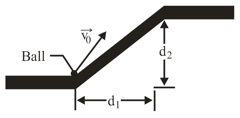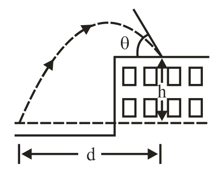A golfer hits a golf ball into the air over level ground. The velocity of the ball at a height of is , with horizontal and upward. Find
the maximum height of the ball and
the total horizontal distance traveled by the ball, what is the
magnitude and
angle (below the horizontal) of the ball's velocity just before it touches the ground?

Important Questions on Motion in Two and Three Dimensions
A baseball leaves a pitcher's hand horizontally at a speed of . The distance to the batter is .
How long does the ball take to travel the first half of that distance?
The second half?
How far does the ball fall freely during the first half?
During the second half?
Why aren't the quantities in and equal?
In the figure given below, a ball is launched with a velocity of magnitude , at an angle of to the horizontal. The launch point is at the base of a ramp of horizontal length and height . A plateau is located at the top of the ramp.
Does the ball land on the ramp or the plateau?
When it lands, what are the
magnitude and
the angle of its displacement from the launch point?

A batter hits a pitched ball when the centre of the ball is above the ground. The ball leaves the bat at an angle with the ground. With that launch, the ball should have a horizontal range (returning to launch level) of .
(a) Does the ball clear a high fence that is horizontally from the launch point?
(b) At the fence, what is the distance between the fence top and the ball center?
As shown in the figure below, a ball is thrown up onto a roof, landing later at height above the release level. The ball's path just before landing is angled at with the roof.
Find the horizontal distance it travels. What are the
magnitude and
angle (relative to the horizontal) of the balls initial velocity?

A football kicker can give the ball an initial speed of . What are the
least and greatest elevation angles at which he can kick the ball to score a field goal from a point in front of the goalpost whose horizontal bar is above the ground?
Two seconds after being projected from ground level, a projectile is displaced horizontally and vertically above its launch point. What are the
horizontal and vertical components of the initial velocity of the projectile?
At the instant, the projectile achieves its maximum height above ground level, how far it is displaced horizontally from the launch point?
A skilled skier knows to jump upwards before reaching a downward slope. Consider a jump in which the launch speed is , the launch angle is , the initial course is approximately flat and the steeper track has a slope of . Figure (a) shows a pre jump that allows the skier to land on the top portion of the steeper track. Figure (b) shows a jump at the edge of the steeper track. In figure (a), the skier lands at approximately the launch level.
(a) In the landing, what is the angle between the skier's path and the slope?
(b) How far below the launch level does the skier land?
(c) What is ? (the greater fall and greater can result in loss of control in landing)

(a) (b)
